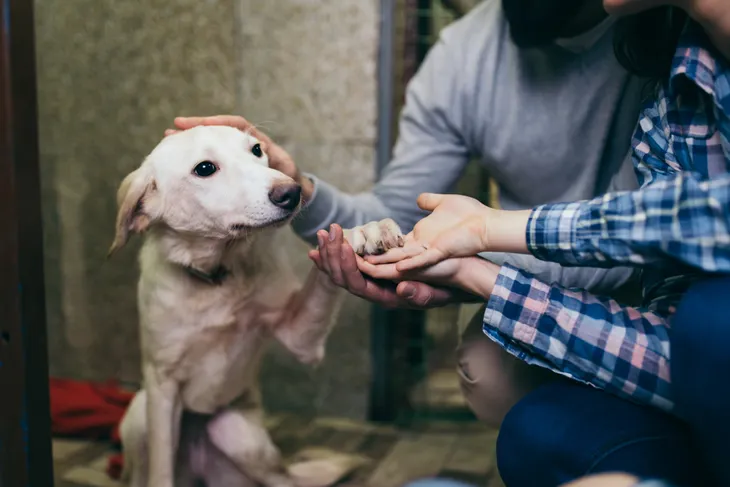The holidays can literally be brought to life when you give a gift that has four paws (or perhaps you’re giving yourself a gift). In any case, a dog or cat can be a wonderful offering during Christmas, as long as you keep some things in mind.
Cuddling with a new furry friend during the holidays can be an uplifting and magical experience for recipients of any age. However, adopting a pet can be a bit of process, and there are a number of factors to explore – we’ll take a closer look at seven of them.
Consider Age of the Recipient
Who is your gift for? Is it a 45-year old with a home that’s suitable for an animal, or is it a 4-year old that doesn’t yet know how to properly take care of themselves? While it’s tough to say “no” to a toddler that’s begging for a kitten for Christmas, consider how much work it will actually end up being for you (or the parents of the child you’re giving the pet to).
Petfinder.com said that if your intended recipient is still too young for a dog or cat, perhaps you can take a look at some lower-maintenance pets like a guinea pig (or a hamster). Think of animals that don’t need a lot of space, a lot of food, constant attention or outdoor supervision.
Let the Recipient Choose their Pet
Rather than unleashing a dog on a surprised new owner, you can go another route, notes American Humane. Rather than picking out an animal to give based on what you think they’d enjoy, prepare an “adoption kit” filled with supplies like toys and food, along with a gift certificate that covers adoption fees at a local shelter.
This way, you can either bring your little ones with you so they can choose a pet based on one that they seem to connect with. Or, if it’s for an older recipient, they can go and choose an animal based on what they can best accommodate.
Don’t Overstimulate a New Pet
Many shelter animals have come from stressful situations, and if you’re bringing one home during the holidays, you may be overloading them again due to extra activity in your household. Puppies in particular can be easily scared by new surroundings, notes PetRescue.com. “The first fear/avoidance period in a puppy’s development occurs roughly between 7-12 weeks of age,” notes the source.
That being said, this age range is also when a puppy can best bond with a new adoptive family, but under normal circumstances. The source notes that any fear learned in the first weeks of a puppy’s life can be difficult to overcome, even with training. “Traumatic experiences at this point can have a permanent impact on your puppy’s personality as an adult dog,” it adds.
Make Sure You’ve ‘Puppy-Proofed’ Your Home
If you’ve opted to adopt a canine for Christmas, then you should not only have the right toys and food at the ready, you should also have your home prepared for the new resident. Introducing a puppy to a home can be a bit like having a toddler: imagine what they can put in their mouth that might be dangerous, or anything they could climb on that could be a hazard.
For dogs, you should put away trashcans and diaper pails into closets so they can’t get into them. Cover unused electrical outlets, secure lamps, and put away potentially poisonous cleaning supplies (be mindful of any mouse/rat traps you have set up). Check your yard fence to ensure there are no weak spots they can escape through, notes PetMD.com.
Consider Allergies First
Perhaps you’re bringing home a cute kitty or doggie for the first time during the holidays, but what if you literally are allergic to them? That can pose a problem that might mean you have to give up the pet after your kids have already bonded with them, which can be heartbreaking.
PetFinder.com said that allergies are actually among the top reasons animals end up in shelters to begin with. However, the source notes you can actually be tested for pet allergies before you bring one home. The most effective way is to be scratched by a device that contains pet dander to see if there’s any reaction within 20-minutes or so. You can also hang out with a friend’s pet to see if you have any telltale symptoms like sneezing or watery eyes.
Foster the Idea of Adoption
The News&Observer based in Raleigh, North Carolina explains that you don’t have to fully commit to adoption before knowing if the animal is the right fit for your family. Sort of a like a “rent to own” car agreement, there’s a “foster to adopt” process for shelter animals.
This allows you to “test drive” a new cat or dog before fully committing, notes the source. “Fostering allows you to take the time an animal needs to adjust to a new situation without committing to that adoption,” it adds. It may take your new furry friend a few days to settle down from the excitement of being moved from their previous home.
Consider Long-Term Costs
Cats and dogs are not cheap pets to keep happy and healthy. Giving a pet to someone for Christmas could actually place a considerable financial strain on them that they’re not prepared for, so it’s best to do some math beforehand.
Let’s focus on puppies for the purpose of this article: the American Kennel Club explains that some statistics peg the cost of raising a puppy at up to $3,329 for the first year alone. These puppies will only need more food (and potential surgeries to have them fixed) later on, so choose wisely. Perhaps ask the shelter if the animal has had their shots or if they display any sort of condition that requires ongoing medication or vet care.










